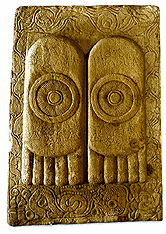
Mauryan period, 1st century BCE
From the Great Stupa at Amaravati, Guntur District, Andhra Pradesh
Sandstone
Height: 67.5 cm
Width: 46.25 cm
Thickness: 15 cm
Acquisition number: # OA 1880.7-9.57
Transferred from the India Museum
Image courtesy of the British Museum (copyright reserved).
During the earliest period of Buddhist sculpture in India, artists did not depict the historical Buddha Sakyamuni directly. Rather, he was referenced through a variety of symbols, using what is known as "aniconic depiction" (for a more detailed discussion on aniconic representation, follow this link to the Buddhism pages) (ps245436.doc). This image of the Buddhapada (footprints of the Buddha) is an example of this representational strategy.
As explained by experts at the British Museum, the footprints are decorated with symbols that demonstrate that the divine nature of the Buddha. Most prominent are the spoked wheels at the center of each foot. These are representations of the Dharmachakras, the Wheel of the Law, which the Buddha set in motion on the occasion of this First Sermon. Close examination of the heels reveals the presence of triratnas (a trident-shaped object), representing the three Jewels of Buddhism: the Buddha himself, the Dharma (the Buddhist Law) and the sangha (the community of Buddhist monks). Around the footprints is an interweaving design of vines, flowers and leafy branches. At bottom right corner can be seen a yaksa, a fertility spirit, who sprouts a fruit-laden vine out of his navel.1
(1) From the British Museum web site dedicated to this object.